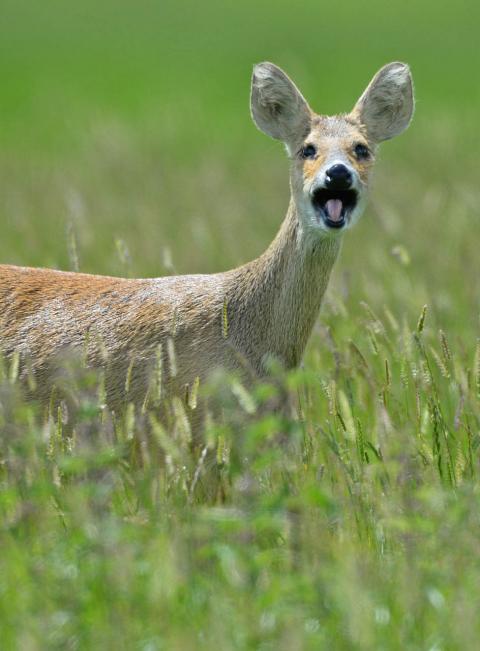Anyone with experience of the deer rut knows that it's a noisy affair, with the stags and bucks barking, roaring, whistling and belching to advertise their fitness to females and ward off potential rivals. Some of the dominant males will vocalise pretty much non-stop, night and day, for two weeks. Similarly, the Reeves' muntjac (Muntiacus reevesi) isn't colloquially referred to as "the barking deer" for nothing. I've sat in the New Forest and listened to a buck barking for 40 minutes without seeming to tire or bore. I've also lain awake for several hours during a summer night listening to water deer barking back and forth to one another.

So, we know that deer are vocal animals and depending on species and season, persistently vocal species, but what allows them to intonate for such long periods without apparently suffering? After all, prolonged duration singing or shouting typically causes we humans to lose our voice.
Firstly, we need to address the question of whether prolonged vocalisation is detrimental to the vocal health of deer. At the time of writing, this question only appears to have been studied in fallow deer (Dama dama). Elisabetta Vannoni at NewBehavior AG in Zürich and Alan McElligott at London's Queen Mary University studied the groaning/belching behaviour of 20 fallow bucks at Phoenix Park in Dublin between 2002 and 2004. Their frequency analysis of the vocalisations, published in Animal Behaviour during 2009, revealed that although the fundamental frequency perturbation along the groan of fallow deer remained stable throughout the rut, the number of pulses and duration of the groans decreased linearly. On other words, the groans didn't get any more jittery/warbly as the rut wore on, but each groan was shorter and there were fewer of them, suggesting that bucks do get hoarse towards the end of the rut.
Despite all this acoustic advertisement taking some toll on the bucks, they're still able to sustain some vocalisation over a period of weeks, long after we'd have shouted ourselves hoarse, implying they have some adaptation(s) that reduces the impact of protracted calling. Interestingly, however, I have found nothing in the literature on this subject. Consequently, I asked the question to some comparative anatomists; Joy Reidenberg at the Icahn School of Medicine at Mount Sinai, Leibniz Institute for Zoo and Wildlife Research’s Roland Frey and Alan McElligott. None of the biologists were aware of any specific adaptations to the vocal anatomy that would prevent them from becoming hoarse having been documented.
The consensus among the anatomists was that deer probably produce a lot of tracheolaryngeal mucus. When mammals speak/call they engage twinned infoldings of the mucous membrane in their larynx known as vocal folds. Air flowing out of the lungs causes these structures to vibrate and this is what generates the sound, the frequency of the vibration determining the pitch of the voice. Dry vocal folds don't vibrate easily and can become irritated/inflamed, which we think this is probably what causes the hoarse sound we recognise after talking for long periods. Hence, the production of copious amounts of mucus to keep the vocal cords well lubricated would represent a measure to reduce the risk of getting hoarse and increase the time over which deer can vocalise. During the rut, Dr Frey pointed out that this mucus production is likely supported by the enhanced hormonal state of the bucks/stags.
If extra lubrication is the key to sustaining deer calls, presumably muntjac more generally produce a lot of mucus as bucks and does bark throughout the year. Certainly, muntjac evolved in dense forests of Asia, where sound is an important means of communication with the neighbours. This may have driven an increased production of mucus in this species compared with deer that have evolved in more open habitats.